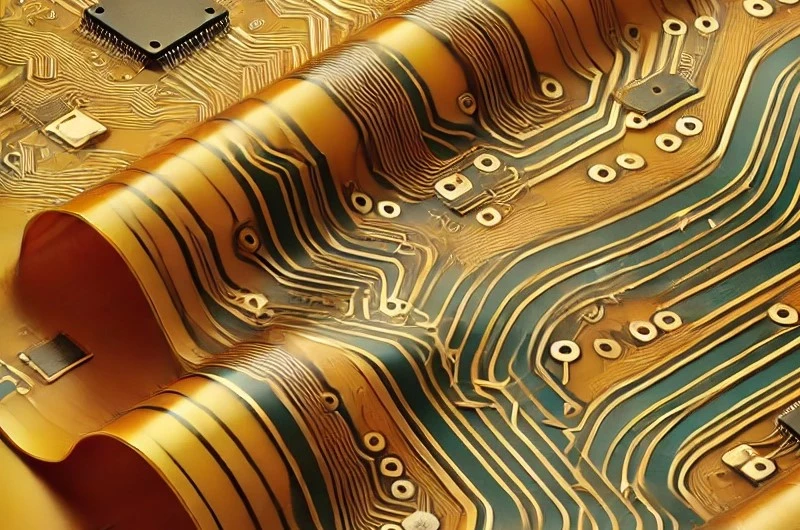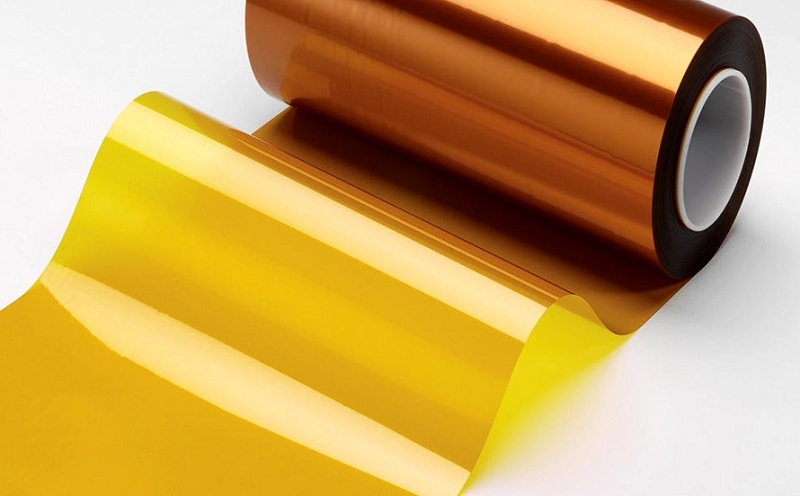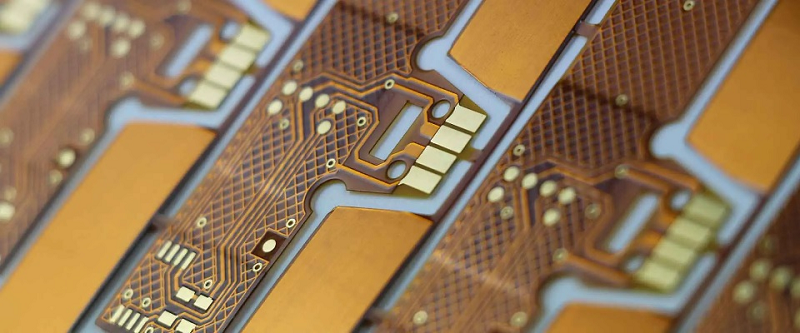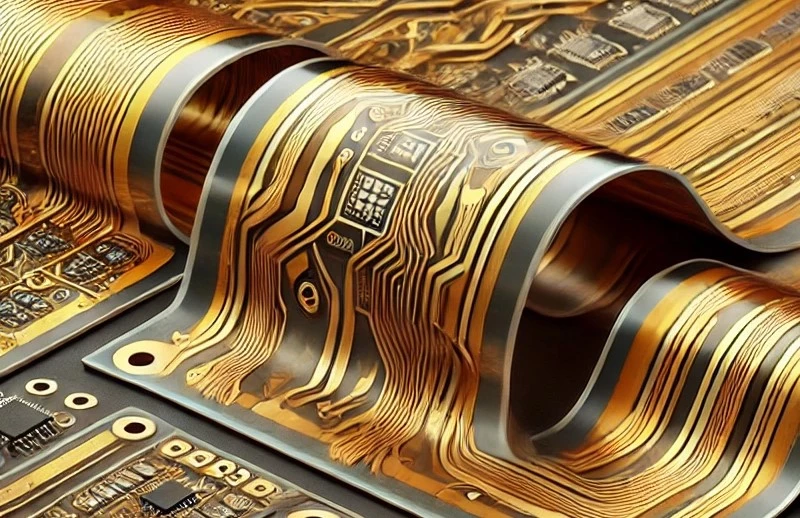Global high-mix volume high-speed Shenzhen PCBA manufacturer

Ru
9:00 -18:00, Mon. - Fri. (GMT+8)
9:00 -12:00, Sat. (GMT+8)
(Except Chinese public holidays)





Global high-mix volume high-speed Shenzhen PCBA manufacturer

Ru
9:00 -18:00, Mon. - Fri. (GMT+8)
9:00 -12:00, Sat. (GMT+8)
(Except Chinese public holidays)





HomePage > Blog > Knowledge Base > Polyimide PCB: Properties, Types, and Differences with FR4
Polyimide PCBs are distinguished special materials due to their peculiar characteristics associated with harsh environments, In comparison to other materials. When subjected to high temperatures, these PCBs exhibit long term stability as their structure tends to stay intact. Thus they are well suited for applications where there is a need to apply mechanical stress or strain.
Polyimide is one of the most useful polymers as it is able to withstand extreme mechanical stress such as physical strain as well as chemical and thermal exposure. These qualities make polyimides favorable for the automotive and aerospace industry, where such high endurance benefits are desired. Automotive electronics are almost always required to be stable when subjected to extreme and repeated thermal cycling. For such applications, polyimide proves to work remarkably well.
Polyimide flex PCBs also have the additional advantage of being used for flexible and rigid-flex applications. These can usually be produced from polyimide polymer plastic base materials accentuated with copper, which allows for maximum endurance and flexibility at the same time.

Polyimide printed circuit boards are constructed out of polyimide material due to its superior mechanical and thermal attributes. These boards are built stronger than the commonly used materials like FR-4. This makes polyimide PCBs more dependable in extreme conditions found in electronics used in aerospace, automotive, or even medical surgeries.
These types of PCBs fall into three main categories: rigid, flexible, and rigid-flex. Rigid polyimide PCBs are extremely strong hence they are used where rigidness and durability is necessary. Polyimide flex PCBs are these, which are meant to be bent and twisted to fit into small applications like portable medical devices. And the Rigid-flex is the combination of both, versatile and complex designs meant for powerful communication devises.
Polyimide PCBs come in different forms, providing versatility:
Pure Polyimides
Second-generation polyimides (pure polyimide) are increasingly used because of their durability and environmentally friendly traits. They do not emit brominated flame retardants, making them less toxic and more eco-friendly. These polyimides are renowned for being able to endure very high temperature and retaining their shape under stressful environments. This property makes them preferred materials to use in industries such as aerospace and healthcare, where there is extreme heating.
Third Generation Polyimides
These advanced polyimides are more durable and flexible than their predecessors. These are better suited for use in high-strength flex applications such as those found in the aerospace, automotive, and telecommunications industries because they now have a higher resistance to moisture and heat.
Low Flow Polyimides
Low-flow polyimides were developed to control resin flow in board manufacturing during PCB assembly for more complex designs like rigid-flex multi-layered PCBs. They are also ideal for mechanical applications that experience high, continuous stress, including aerospace and automotive industries, because of their high thermal resistance and superior abrasion resistance.
Filled Polyimides
These comprise various materials, including ceramic particles, metal oxides, and glass fibers, which enhance the strength, heat resistance, and electrical performance of polyimides. These polyimides are ideal for use in extreme environments and applications involving high frequency signals. Their use is common in the aerospace, automotive and even healthcare industries because they are reliable for high performance PCBs in a wide range of industries.
Polyimide PCBs are produced using a composite of materials renowned for their flexibility and high thermal resistance along with their strength. At their core is polyimide, a polymer that can survive extreme temperatures without losing its structure. Thus, polyimide boards fare much better than traditional FR-4 boards, which are manufactured out of fiberglass and epoxy resin and polyimide boards.
One defining feature of polyimide PCBs is their ability to withstand extremely high temperatures, dissipation factor (Df), and extensive physical stress. This is especially true for industries such as aerospace, automotive, and even consumer electronics. In the aerospace sector, these boards can withstand intense heat and radiation while maintaining their integrity. In consumer electronics, the lightweight and flexible nature of these boards is a huge benefit.
However, choosing the right materials tailored for specific applications is vital. This is especially true in critical environments where the wrong combination can lead to failures. Take for example, high heat applications such as power supplies that require polyimides due to their superior thermal resistance compared to other polymers. Also, copper thickness is critical for current capacity and signal quality. Even the adhesive between layers sheared can impact the flexibility and durable of the board.

Compared to other types, Polyimide PCBs have amazing dimensional stability and increased reliability. Their physical properties allow them to be flexible yet tough enough for items that must be put through a lot of movements or tough conditions.
• Flexibility: From wearable technology to foldable devices, it's no surprise that these PCBs can be made into any shape anyone desires.
• Heat Resistance: Suitable for aerospace and automotive utilizations, these PCBs can be exposed to temperatures of up to 572 Fahrenheit.
• Durability: These PCBs prove to have extended life durations even in harsh industrial or medical environments because they are resistant to mechanical and chemical damage.
• Electrical Performance: Polyimide is a powerful insulator that prevents electric failures and ensures rapid signal transfer. This makes it a good fit for applications that need high frequency like radars and telecommunications equipment.
Comparison with Other PCB Materials like FR4
Polyimide PCBs have significant differences when compared to FR4 PCBs:
Cost: Equal polyimide boards remain more expensive than FR4 boards because of the higher demand for their properties.
Flexibility: Polyimide performs better than FR4 in all applications that involve movement due to the fact that polyimides are more flexible than FR4's rigidity.
Thermal Resistance: Polyimides have no temperature limitations. They can be used in extreme conditions, while FR4 can only tolerate moderate heat.
In conclusion, polyimide PCBs are the preferred choice for high flexing and temperature applications while FR4 best serves while retaining rigidity at a lower cost.
Like other polymers, Polyimide PCB materials can be classified depending on their main chain composition:
Aromatic Polyimides: These are used in aerospace and satellites because of their strength and exceptional thermal stability.
Aliphatic Polyimides: These are ideal for optical devices due to their high transparency.
Based on the Inclusion of Additives, PCB Polyimide materials can be classified depending on the properties:
Glass Fibers: These increase mechanical strength; hence, they are beneficial for high-stress environments.
Ceramic Particles: These enhance thermal conductivity, which is always needed for high-power devices.
Selecting the appropriate kind and additives makes it possible for the PCB to have particular desired performance characteristics, whether it is targeting a flexible wearable gadget or a high-powered industrial machine.

FR4 is among the commonly used materials in making printed circuit boards (PCBs). It is relatively cheap and possesses remarkable strength. It is a composite material formed by resin, which has high heat tolerance epoxy, and woven fiberglass cloth. The material is also self-extinguishing. The "FR" in FR4 stands for "flame retardant." It is widely used because of its strength, ability to insulate, and resist moderate temperatures.
Comparisons of Polyimide and FR4 PCBs make them shine because of their distinct advantages and ideal use cases:
Heat Resistance: Polyimide PCBs have the ability to tolerate over 500° F so they are used in the aerospace and automotive applications. FR4 tolerates temperatures below 284° F, which can be detrimental in some high-temperature operating environments.
Flexibility: Polyimide PCBs are preferable for wearable electronics and portable electronics due to their flexibility and resistance to cracking upon bending and twisting. Versatile designs are not possible with FR4 PCBs because they are rigid.
Cost: The cost of an FR4 PCB is lower than that of a Polyimide PCB because of its low material and manufacturing costs. However, Polyimide PCBs do operate at a higher level in extreme environments.
Chemical Resistance: Polyimide materials have high resistance to chemical degradation which allows for use in extreme industrial environments. FR4 provides modest chemical resistance that is useful but not as robust as polyimide.
Electrical Performance: One of the things Polyimide PCBs are praised about is their electrically insulation which alongside their fast signal transmissions makes them operate at the high frequency and power applications. FR4 employs dependable electrical performance for other standard uses but may lack more technological forward applications.
In summary, choosing between Polyimide and FR4 PCBs highly depends on the specific use case. For high-performance, flexible, and heat-resistant applications, Polyimide PCBs are the first choice while FR4 PCBs are used where cost-effectiveness and performance is required.
Polyamide is the term used for a class of synthetic polymers which are simply referred to as nylons. It is a compound that is applied in many sectors, from fabrics to industrial parts. Polyamide is strong, resistant to tearing, and very durable. Its production involves the polymerizing of dicarboxylic acids and the associated diamines.
Polyimide and polyamide are two distinct classes of high-performance polymers, but they are structurally different from each other in a great deal of ways; among them are their characteristics, uses and methods of manufacturing:
Chemical Composition:
Polyimide is synthesized from the imide groups, providing strong thermal stability and a high resistance to chemicals.
Polyamide consists of amide groups and is well known for its mechanical strength; however, it has a weaker heat resistance than polyimide
Thermal Stability:
Polyimide is also a better heat resistant copolymer and is exploited in field where extreme temperatures are experienced (above 500 F, 260 C).
Polyamide can generally endure temperature within the range of 180-250 F (82-121 C).
Mechanical Properties:
Polyamide is tough, high strength material with a good resistance to creep, and thus ideal in more stressful applications in cases such as aerospace as well as electronics.
Polyamide is somewhat pliable; hence, it is usually utilized in textiles, automotive parts, and even consumer products.
Applications:
Polyimide, on the other hand, is mostly found in the production of flexible circuits, insulating films, and parts that operate under high temperatures.
Polyamide Is found in Fabrics, automotive parts, electrical insulators, and food containers.
Cost:
The cost of polyimide is always above average because of the particular features it has and the way it is manufactured.
Polyamide is more affordable for low or mid-level items in high demand by the general population.

In the process of manufacturing polyimide PCBs, the first step consists of preparing the polyimide substrate. Thin polyimide films, usually in roll form, are cleaned and cut to appropriate sizes. It is important that the substrate is washed well to remove any oils, dirt, or leftover residues that could negatively affect the quality of the final PCB. At this step, surface treatment or activation might also be necessary to obtain the proper bonding of the next layers.
Surface treatment aids in increasing the adhesion between the polyimide substrate and the metal layers. Adherence of metal foils can be improved by this process which can be accomplished by plasma treatment or chemical etching. Sometimes, a bonding resin or adhesive is first applied to the surface to improve bonding with the copper or other metal layers.
During metallization, the polyimide substrate is coated with a thin layer of metal (generally copper). This is usually done by sputtering or electroplating. The metal layer of a PCB serves as a conductor. The thickness of the metal layer varies depending on the application and design of the PCB.
Imaging and patterning entail the processes of loading the PCB circuit schematic diagram on the metallized polyimide substrate. The metal surface is coated with photoresist which is later exposed to the UV light through a photo mask with the circuit design. Exposed regions of the photoresist become rigid and the non-exposed remain soluble. Afterwards the unexposed photoresist can be washed to reveal the metal pattern for electrical circuits.
The last phase is concerned with finishing the polyimide PCB in a manner that meets all necessary specifications. This comprises etching back the excess metal, washing the board, and applying coatings.
Polyimide PCBs may go through other processes like gold plating or even the application of solder masks to the metal traces for protection from oxidation and abrasion. Lastly, the board is visually inspected for all kinds of defects and any other possible tests such as conductance testing may be performed to confirm that they operate correctly and securely.
Consumer-Based Applications
Many different consumer electronics now a days are adopting polyimide PCBs because of their flexibility, thermal stability, and robustness. These boards are critical in systems where space and weight are at a premium, and compact high-performance circuits are needed. These include mobile phones, wearable laptops and cameras.
Polyimide Circuit Boards in the Automotive Industry
In reference to the car sector, polyimide PCBs have great relevance to the more sophisticated technologies of ADAS features, EVs, and electric powertrains. Polyimide materials have unique characteristics.
This attribute, together with the capacity of polyimide to withstand high temperatures, makes it perfectly suitable to the engines of control units, sensors, and electric systems.
Medical Diagnostics and Treatment Equipment
Due to the spin on PCBs, they are widely applied in diagnostic and therapeutic equipment due to the devices' biocompatibility. They can be integrated into MRI machines, pacers, hearing aids, and infusion pumps. The critical performance of polyimide PCBs under high temperatures and humidity is indispensable for the progressive healthcare system where high reliability and precision are mandatory for the safety of the patients.
Military and Aerospace Applications
Polyimide PCBs have a broad application in the military and aerospace industries, since they are extremely reliable and can perform well under hostile environments. Polyimide circuit boards are used in satellites, avionics, radar, and military communication devices. They are able to endure high levels of radiation, extreme temperatures, and mechanical stress associated with space and defense gears. The lightweight property of polyimide PCBs allows them to be used in designs that require minimum weight in aerospace technology, which makes it easier for airplanes to lift off the ground.
Polyimide PCBs serve a wide breadth of applications, ranging from aerospace to medical devices highly dependent on performance and reliability, while withstanding extreme environments. Polyimide PCBs take first place for their robustness and bendability, while also withstanding high temperatures and extreme environments.
Understanding their characteristics alongside the FR4 materials will help you make better decisions. Polyimide PCBs have repeatedly proved their value in modern system technology or high-performance units.

Assembly Enquiry
Instant Quote